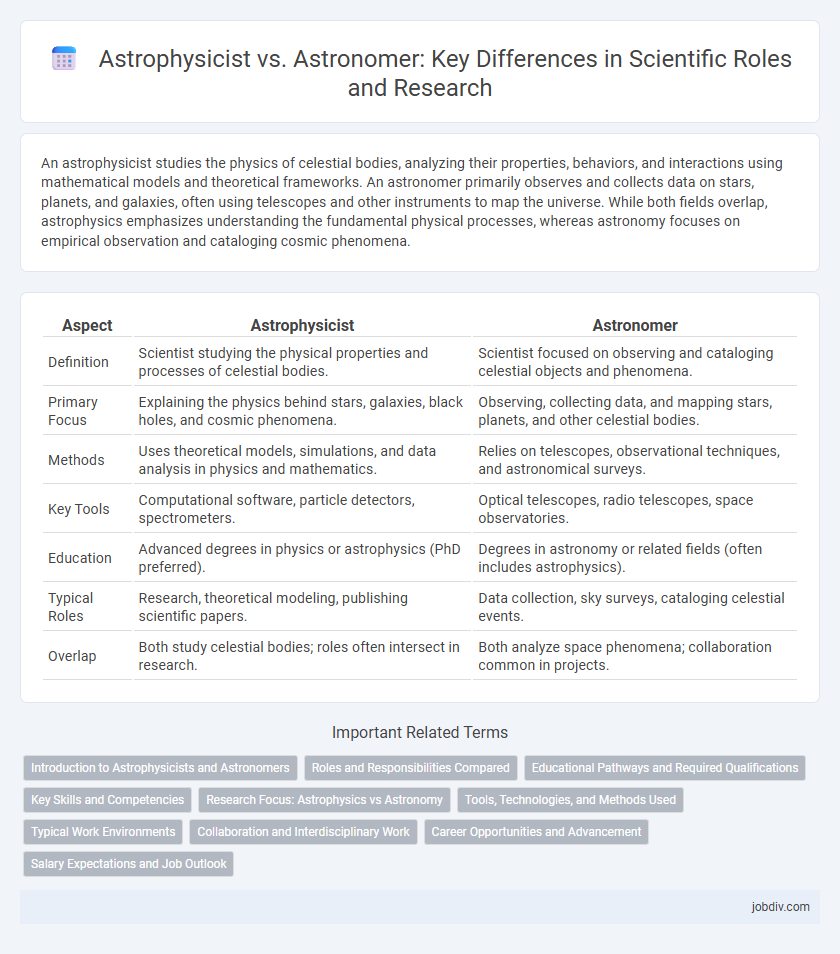An astrophysicist studies the physics of celestial bodies, analyzing their properties, behaviors, and interactions using mathematical models and theoretical frameworks. An astronomer primarily observes and collects data on stars, planets, and galaxies, often using telescopes and other instruments to map the universe. While both fields overlap, astrophysics emphasizes understanding the fundamental physical processes, whereas astronomy focuses on empirical observation and cataloging cosmic phenomena.
Table of Comparison
| Aspect | Astrophysicist | Astronomer |
|---|---|---|
| Definition | Scientist studying the physical properties and processes of celestial bodies. | Scientist focused on observing and cataloging celestial objects and phenomena. |
| Primary Focus | Explaining the physics behind stars, galaxies, black holes, and cosmic phenomena. | Observing, collecting data, and mapping stars, planets, and other celestial bodies. |
| Methods | Uses theoretical models, simulations, and data analysis in physics and mathematics. | Relies on telescopes, observational techniques, and astronomical surveys. |
| Key Tools | Computational software, particle detectors, spectrometers. | Optical telescopes, radio telescopes, space observatories. |
| Education | Advanced degrees in physics or astrophysics (PhD preferred). | Degrees in astronomy or related fields (often includes astrophysics). |
| Typical Roles | Research, theoretical modeling, publishing scientific papers. | Data collection, sky surveys, cataloging celestial events. |
| Overlap | Both study celestial bodies; roles often intersect in research. | Both analyze space phenomena; collaboration common in projects. |
Introduction to Astrophysicists and Astronomers
Astrophysicists analyze the physical properties and underlying processes of celestial bodies, employing principles of physics to explain cosmic phenomena such as black holes and supernovae. Astronomers primarily observe and catalog celestial objects, utilizing telescopes and other instruments to gather data on star formations, planetary motions, and galactic structures. Both fields contribute to our understanding of the universe, but astrophysics emphasizes theoretical modeling while astronomy focuses on observational techniques.
Roles and Responsibilities Compared
Astrophysicists primarily analyze the physical properties and behavior of celestial bodies using theoretical models and computational simulations, focusing on understanding cosmic phenomena such as black holes and dark matter. Astronomers concentrate on observing and cataloging stars, planets, and galaxies through telescopes and other instruments to gather empirical data about their positions, motions, and luminosities. Both roles often overlap in data interpretation, but astrophysicists emphasize theoretical physics while astronomers prioritize observational techniques.
Educational Pathways and Required Qualifications
Astrophysicists typically pursue advanced degrees such as a Ph.D. in physics or astrophysics, emphasizing theoretical and experimental research in celestial phenomena. Astronomers often hold degrees in astronomy or related fields, with a strong foundation in observational techniques and data analysis obtained through a bachelor's or master's program. Both careers require proficiency in mathematics, physics, and computer science, but astrophysicists engage more deeply in modeling and simulations, while astronomers focus extensively on telescope operations and empirical data collection.
Key Skills and Competencies
Astrophysicists possess advanced skills in theoretical modeling, complex data analysis, and the application of quantum mechanics to understand celestial phenomena, often requiring proficiency in computer programming and statistical methods. Astronomers excel in observational techniques, utilizing telescopes and instrumentation to collect and interpret electromagnetic radiation data across various wavelengths, alongside expertise in celestial navigation and spatial measurement. Both professions demand strong mathematical aptitude, critical thinking, and the ability to conduct rigorous scientific research, but astrophysicists typically emphasize theoretical and computational skills while astronomers focus on empirical observation and data acquisition.
Research Focus: Astrophysics vs Astronomy
Astrophysicists specialize in applying physics principles to understand the behavior, properties, and interactions of celestial objects, focusing on phenomena such as black holes, neutron stars, and cosmic microwave background radiation. Astronomers primarily observe and catalog celestial bodies including stars, planets, and galaxies, often using telescopes and data analysis to map the universe's structure and evolution. Both fields overlap in studying the cosmos, but astrophysics emphasizes theoretical modeling and physical explanations, while astronomy concentrates on observation and empirical data collection.
Tools, Technologies, and Methods Used
Astrophysicists utilize advanced computational simulations, particle detectors, and space-based observatories like the Hubble Space Telescope to analyze cosmic phenomena at a theoretical and experimental level. Astronomers employ ground-based telescopes, spectrographs, and CCD imaging technology to observe and collect data on celestial objects and events. Both disciplines increasingly incorporate machine learning algorithms and high-performance computing to process vast datasets and enhance accuracy in modeling and observation.
Typical Work Environments
Astrophysicists typically work in research institutions, universities, or government laboratories where they analyze cosmic phenomena using advanced theoretical models and simulations. Astronomers are often found at observatories, planetariums, or space agencies, operating telescopes and collecting empirical data from celestial objects. Both professions collaborate in academic settings but diverge significantly in their hands-on observational versus theoretical research environments.
Collaboration and Interdisciplinary Work
Astrophysicists and astronomers frequently collaborate to enhance understanding of cosmic phenomena through interdisciplinary methods combining theoretical physics, observational data, and advanced computational techniques. Their joint efforts integrate expertise in particle physics, cosmology, and space instrumentation, driving innovations in telescope technology and data analysis algorithms. This synergy accelerates discoveries in dark matter, cosmic microwave background radiation, and exoplanet characterization, bridging gaps between empirical observations and theoretical models.
Career Opportunities and Advancement
Astrophysicists typically engage in theoretical modeling and data analysis to understand cosmic phenomena, requiring advanced degrees such as a Ph.D. for research leadership roles and university positions. Astronomers focus on observational studies using telescopes and instrumentation, with career advancement opportunities in research institutions, observatories, and space agencies like NASA. Both fields offer pathways into academia, government research, and private aerospace companies, but astrophysicists often experience broader roles in theoretical physics and computational methods.
Salary Expectations and Job Outlook
Astrophysicists typically earn higher salaries than astronomers, with average annual incomes ranging from $95,000 to $130,000, reflecting their specialized focus on theoretical models and complex simulations. The job outlook for astrophysicists is projected to grow by approximately 6% over the next decade, driven by advances in space research and technology development. Astronomers, with a median salary near $85,000, face steady job growth around 5%, primarily supported by demand in academic institutions and space agencies.
Astrophysicist vs Astronomer Infographic

 jobdiv.com
jobdiv.com